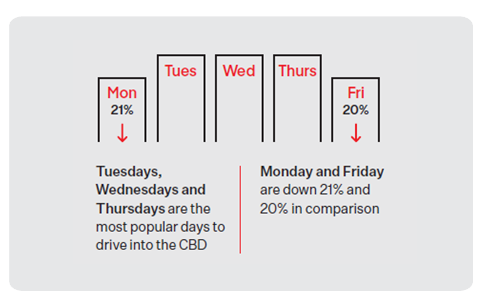Australia’s urban landscapes are undergoing a significant transformation. There’s large-scale development in infrastructure for cyclists and public transport users, as well as more pedestrian-focused spaces.
In Victoria, the City of Melbourne’s proposed Future Streets Framework 2030 and Beyond outlines the redesign of streets in the CBD Hoddle Grid to reduce central city through-traffic. Proposed plans include:
- The narrowing of traffic lanes
- Re-allocating on-street parking to people space
- Converting some streets into pedestrian-priority zones
- Working towards a maximum of one traffic lane each on the majority of streets with the CBD Hoddle Grid.
In New South Wales, the City of Sydney has outlined a Sustainable Sydney 2030-2050 action plan for a ‘calmer’ city. This seeks to reduce vehicle speeds and volumes in the city centre, allowing for wider footpaths and more options for people wanting to cycle.
Additionally, many new Category A buildings have increased the prioritisation of end of trip facilities, taking up space that would traditionally be assigned for parking.
Despite the long-term vision of greener cities, most commuters continue to favour driving to work and use of public transport in major cities such as Sydney continues to be 15% below pre-COVID levels. [1]
[1] NSW Public Transport data 2024
The impact to commuters
The car remains the most popular choice, due its flexibility and convenience, with 58% of commuters choosing to drive to the CBD for work.[2] Congestion caused by changes in infrastructure and reduction in parking bays will inevitably lead to a harder and reluctant commute, making parking space and availability to become even more premium than it is today.
[2] Wilson Parking Household Survey 2023
Flexible working plays its part in easing the commute
Working and commuting to and from the office has changed. 70% of commuters only travel into the city one to three times per week and 46% can choose when they can come in, or leave the office1.
The option to not travel every day, or to decide to commute outside of peak hours is driving the demand for flexible parking products.
Wilson Parking’s data shows an increase in the more flexible commute, and in turn, the demand for flexible parking products:

- Parking remains focused on three days per week with Monday and Friday’s seeing 20% less demand compared to Tuesday, Wednesday and Thursday
- 128% increase in commuters selecting flexible parking products, over the traditional Early Bird with its limiting restrictions.
Managing limited premium parking
Flexible parking options will go a long way to ease the burden of the commute, allowing customers to find relevant parking options and benefit from other services delivered.
However, if the struggle to find parking becomes a major factor, then this is where digital solutions – that allow commuters to find parking before they have set-off – will shine.
The demand for the convenience of digital solutions continues with 48% of people wanting to use phone/apps to handle the entire process1. Using parking apps, customers are able to plan ahead, and search and prepay for parking in advance.
Tenant parking solutions allow companies to maximise hybrid working and share parking allocation amongst more staff. A completely digital solution, it gives landlords, employers and commuters unparalleled autonomy to manage their parking allocation and access data to improve future planning.
There is no doubt the CBD and commuter landscape will continue to change. Landlords and parking providers need to:
- Evolve with these changes
- Align to shifts in customer behavior
- Utilise data available from parking systems, digital solutions and market insights to understand changes ahead.



